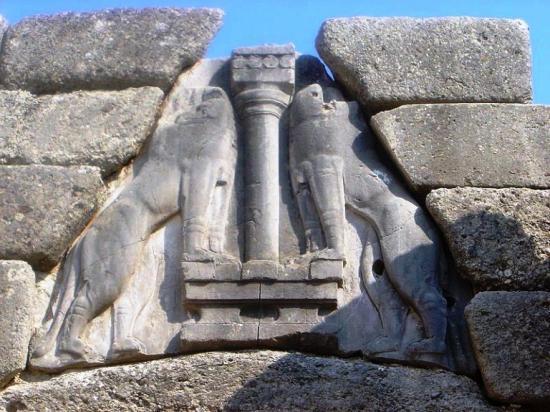The mysterious Mycenaeans in Greek myth and literature
Lori Henshey
Source - http://www.examiner.com/religious-spiritual-mysteries-in-national/the-mysterious-mycenaeans-greek-myth-and-literature#ixzz1RXHiJDWy
Mycenaean Greece (1600 BCE – 1100 BCE) is a cultural period of Bronze Age Greece taking its name from the archaeological site of Mycenae in northeastern Argolis, in the Peloponnese of southern Greece. Athens, Pylos, Thebes, and Tiryns are also important Mycenaean sites. The last phase of the Bronze Age in Ancient Greece, it is the historical setting of much ancient Greek literature and myth, including the epics of Homer. The culture was agressive and achieved most of their accomplishments through warfare rather than trade.

The lion gate at Mycenae. Credit: David Monniaux / 2004
Mycenean religion was polytheistic and the Myceneans were actively syncretistic, adding foreign gods to their pantheon of gods with surprising ease. It involved offerings and sacrifices to the gods, and some have speculated that they involved human sacrifice based on textual evidence and bones found outside tombs. In the Homeric poems, there seems to be a lingering cultural memory of human sacrifice in King Agamemnon's sacrifice of his daughter, Iphigenia; several of the stories of Trojan heroes involve tragic human sacrifice. This, however, is all speculation.
The religious element is difficult to identify in Mycenaean civilization, especially as regards archaeological sites, where it remains problematic to pick out a place of worship with certainty. John Chadwick points out that at least six centuries lie between the earliest settling of proto-Greek speakers in Hellas and the earliest Linear B inscriptions, during which concepts and practices will have fused with indigenous beliefs, and — if cultural influences in material culture reflect influences in religious beliefs — with Minoan religion.

As for these texts, the few lists of offerings that give names of gods as recipients of goods reveal nothing about religious practices, and there is no surviving literature. John Chadwick rejected a confusion of Minoan and Mycenaean religion derived from archaeological correlations and cautioned against "the attempt to uncover the prehistory of classical Greek religion by conjecturing its origins and guessing the meaning of its myths" above all through treacherous etymologies.
Poseidon seems to have occupied a place of privilege. He was a chthonic deity, connected with the earthquakes shaker, but it seems that he also represented the river spirit of the underworld as it often happens in Northern European folklore. Also to be found are a collection of Ladies like the mistress of the Labyrinth at Knossos in Crete, who calls to mind the myth of the Minoan labyrinth. The title was applied to many goddesses.
Demeter and her daughter Persephone, the goddesses of the Eleusinian mysteries, were usually referred to as the two goddesses or the mistresses in historical times. The mysteries were established during the Mycenean period and it seems that they were based on a Pre-Greek vegetation cult with Minoan elements.
Artemis, who was the first nymph, appears as a daughter of Demeter in the Arcadian cults and she became the most popular goddess in Greece. Her precursor goddess (probably Britomarpis) is represented between two lions on a Minoan seal and also on some gold rings from Mycenae. The representations are quite similar with these of Artemis Orthia at Sparta. Found in her temple at Sparta were wooden masks representing human faces that were used by dancers during the vegetation cult. Artemis was also connected with the Minoan cult of the tree an ecstatic and orgiastic cult which is represented on Minoan seals and Mycenean gold rings.
Paean is probably the precursor of the Greek physician of the gods in Iliad. He was the personification of the magic-song which was supposed to heal the patient. Later it became also a song of victory; the magicians were also called seer doctors, a function which was also applied later to Apollo. Other divinities found in later periods have been identified, such as the couple Zeus–Hera, Ares, Hermes, Athena, Dionysus, Eileithyia and Erinya. The names of Apollo and Aphrodite are absent.
There were some ritual sites of importance, such as Lerna, typically in the form of house sanctuaries, since the familiar, free-standing temples containing a cult image in its cella with an open-air altar before it was a later historic development.